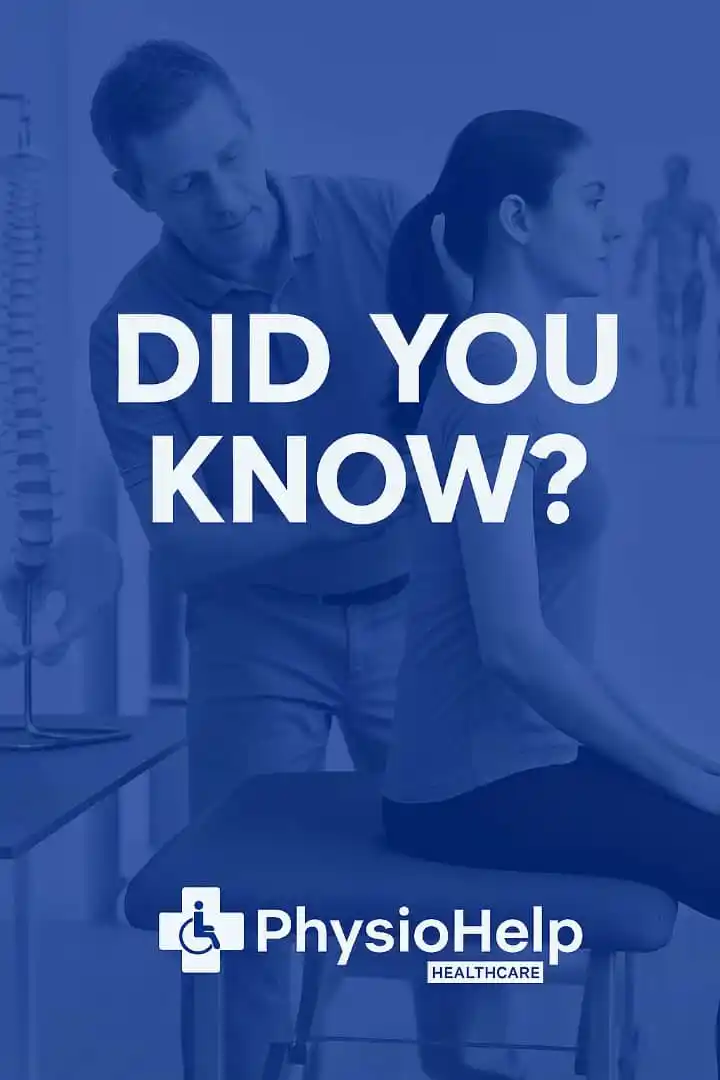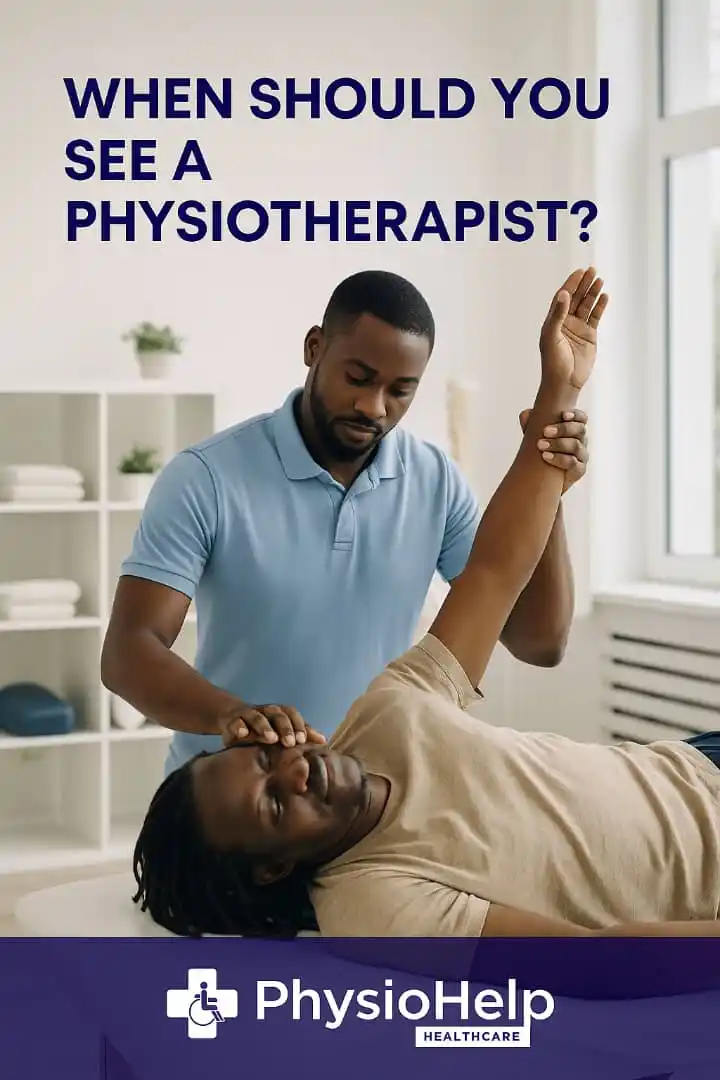
PhysioHelp Healthcare
51 subscribers
About PhysioHelp Healthcare
Physiohelp transforms lives by offering a one stop solution for *physiotherapy needs*, including expert treatments and guidance from qualified physiotherapists dedicated to helping you overcome pain and neurological disability through *natural, non-invasive methods, and minimizing the need for surgery or medications.*
Similar Channels
Swipe to see more
Posts

Happy Eid-l-adha, may Allaah's blessing be with you and your household.


When Should You See a Physiotherapist? Spoiler alert: It’s not only when you can’t walk anymore. Have you ever tried standing up after sitting in traffic for two hours and your back says, “We’re not doing this anymore”? That might just be your body’s way of suggesting it’s time to see a physiotherapist. But First, Who Is a Physiotherapist? A physiotherapist is a healthcare professional who helps people restore movement and function when they’ve been affected by injury, illness, or disability. Contrary to popular belief, they’re not just “massage therapists.” Think of them as movement experts who help you heal, move better, and avoid future problems — kind of like mechanics, but for your body. A QUICK STORY FROM A PATIENT _ADEBAYO_, a 23-year-old Tech expert in Lagos, was a regular at Friday night football games. One evening, while trying to impress his girlfriend with a flashy Neymar-style move, he twisted his knee. “Nothing much” he thought. He did what most of us would do, applied Aboniki, wrapped it up, and hoped for the best. Three weeks later, he still couldn’t bend his knee properly without pain. Finally, his brother, a physiotherapist saw his difficulty in movement, diagnosed him with a ligament strain and created a proper rehab plan. Two months later, _Adebayo_ was back on the field showing skills, maybe not as fast, but definitely smarter. As for the spectators, they had moved on to the next best player. *So, When Should You See a Physiotherapist?* *PERSISTENT PAIN* : If you’ve had pain in your back, neck, shoulder, or joints that won’t go away, especially after a fall, an accident, or even a minor twist, it’s time to check in with a physiotherapist. *LIMITED MOVEMENT* : If you’re finding it hard to move your arm, neck, or leg the way you used to, physiotherapy can help you in restoring flexibility and strength. *POST-SURGERY OR INJURY:* After operations, fractures, or muscle injuries, seeing a physiotherapist can speed up recovery and reduce complications. *MANAGING CHRONIC CONDITIONS:* Conditions like arthritis, stroke, cerebral palsy, or long-term back pain benefit greatly from physiotherapy care. *FOR PREVENTION* : You don’t have to wait until something is wrong. If your job involves repetitive movements like driving, sewing, or even long hours at a desk, a physiotherapist can help you avoid future issues. Listen to Your Body, It’s always sending you a message. The truth is, physiotherapy isn’t only for athletes, old people or accident survivors. It’s for teachers who stand all day, office workers who sit all day, remote workers who abuse their postures daily, parents who carry toddlers, and even students who’ve been hunched over books. So the next time your joints start complaining more than your neighbor during a power outage, don’t ignore the signs. Make sure you see a physiotherapist at PhysioHelp healthcare, your body will thank you for it.

Kindly share once you're done reading and let many more people benefit from the channel.

*Have You Ever Heard of Someone Pulling a Muscle Just from Trying to Look Fit?* One of my guys came to me recently, limping like he just survived a wrestling match. I asked what happened, and he goes, “Bro, I just started gyming this week o.” I said okay, expecting maybe a slight muscle strain. Next thing, he says he can't bend, can’t twist, even sneezing is a problem. That’s when I knew that this wasn’t fitness, this was fitness gone wrong. Apparently, he made up his mind to “build body before Detty December.” First day was cardio. Second day were squats, lunges, press-ups. By the third day, he attempted deadlifts without proper form or warm-up. Fourth day? He couldn’t even bend to wear slippers. He told me, “Omo, I thought I was doing something. I even posted gym videos on my story. Now I dey lie down with ice pack like say na surgery I go do.” It’s funny until you remember how common this is. A lot of people jump into exercise like they’re training for Access Bank Lagos Marathon, forgetting that the body no be machine. No warm-up, no cool-down, just vibes and motivational quotes. And when the injury comes, they now rush to us like “my back just shifted small.” So here’s my two kobo: take your fitness journey gradually. Start small. Warm up. Stretch. Rest. And most importantly, listen to your body before it screams at you in front of the dumbbells. Because trust me, there’s nothing sexy about limping out of a gym session you posted with “No pain, no gain.” Sometimes, that pain means go and see your physiotherapist, just like my guy.


1. Did you know? Poor posture can reduce lung capacity by up to 30%, making it harder for your body to get enough oxygen. 2. Did you know? Good posture boosts confidence and can even positively affect how others perceive you in social or professional settings. 3. Did you know? Standing or sitting with proper alignment helps improve digestion, as slouching can compress abdominal organs. 4. Did you know? Forward head posture (tech neck) adds extra stress on your neck—every inch forward is like adding 10 pounds of weight! 5. Did you know? Posture affects mood—slouching is linked to increased feelings of stress and depression, while upright posture can improve energy and focus. 6. Did you know? Children can develop postural issues early due to heavy school bags and too much screen time—early correction is key! 7. Did you know? Your posture while sleeping also matters—poor sleeping posture can lead to back and neck pain over time. 8. Did you know? Wearing high heels regularly can throw off your posture and contribute to long-term spinal misalignment. 9. Did you know? Desk jobs are one of the leading contributors to postural problems due to prolonged sitting and poor ergonomics. 10. Did you know? Regular stretching and strengthening exercises, especially for your core and back muscles, can significantly improve posture.


Workplace ergonomics is important for maintaining health, preventing Msk injuries, and improving productivity. Poor ergonomics can lead to discomfort, musculoskeletal disorders (MSDs), and long-term health issues. By making some simple adjustments to your workspace, you can create a more comfortable and efficient working environment. 1. *Maintain Proper sitting Posture* Sit with your back straight and shoulders relaxed. Keep your feet flat on the floor or use a footrest. Adjust your chair so your knees are at a 90-degree angle. 2. *Optimize Desk and Chair Setup* Position your monitor at eye level to prevent neck strain. Keep your keyboard and mouse at a comfortable height to avoid wrist pain. Use an adjustable chair with lumbar support for better spinal alignment. 3. *Reduce Repetitive Strain* Take short breaks every 30–60 minutes to stretch and move. Use ergonomic keyboards and wrist supports to prevent carpal tunnel syndrome. Alternate tasks to avoid prolonged repetitive movements. 4. *Improve Lighting and Reduce Screen Strain* Adjust screen brightness and contrast to reduce eye strain. Position your screen to minimize glare from lights or windows. Follow the 20-20-20 rule: every 20 minutes, look at something 20 feet away for 20 seconds. 5. *Encourage Movement* Stand up and stretch regularly to improve circulation. Use a sit-stand desk if possible. Take short walks to avoid prolonged sitting. Implementing these ergonomic practices can enhance comfort, prevent workplace injuries, and boost overall efficiency. A well-designed workspace is not just about productivity—it’s about long-term health and well-being.

Get yourself an ergonomic chair today, your back and neck will thank you for it














